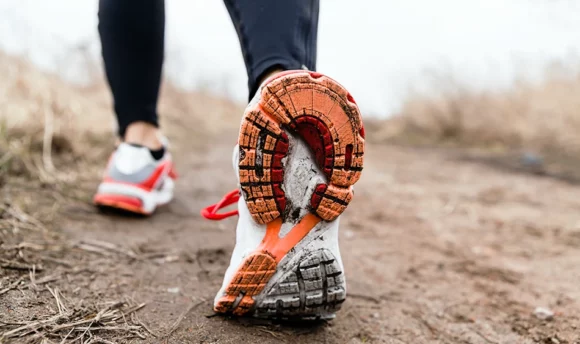Running 5 Miles a Day: 5 Benefits and Tips on How to Prepare
Running 5 miles a day is an impressive feat for runners of any level. Regardless of your running ability, these long-distance runs are available to you and have a multitude of benefits.

If you’ve been running for a while, it’s possible that you want to start including some 5-mile runs into your training schedule.
Generally, these distances are reserved for more serious runners, but that doesn’t mean that runs of these lengths are off-limits to anyone just starting out.
If running 5 miles a day is your goal, this article can help set you up with the knowledge to do so safely. It will also educate you on the different benefits of a steady running routine, which can help you stay consistent in the long run.
Why Is It Worth It to Start Running 5 Miles per Day?
Running 5 miles a day has numerous benefits for both the mind and the body, including improved mental clarity and better cardiovascular health. It can even help to increase your energy levels and improve your mood.
How Long Does It Take to Run 5 Miles?
Everyone’s 5-mile time will be a little bit different and will be dependent on things like cardiovascular health and muscle endurance.
A beginner runner can expect their mile time to be somewhere between 10 and 15 minutes. If they are able to maintain this pace for the duration of their run, that would mean their run would last anywhere from 50–75 minutes.
As you continue building your endurance, you can expect your mile time to get better and better. Elite marathon runners are able to finish off a 5k run in less than 30 minutes.
What Should I Eat Before Running 5 Miles?
If running 5 miles a day is a goal of yours, it’s important that you prepare by fuelling your body properly both before and after your runs. You might be afraid of high-calorie foods, but getting enough calories will be important for sustainable progress.
Protein
High protein is important for anyone doing intense physical activity, as protein cells are the building blocks of the muscles. As you run, you create small tears in the muscles, which protein cells repair while you rest.
High protein foods are things like: chocolate milk, greek yogurt, canned chicken, and fish.
Carbohydrates
Carbs are what give the muscles energy to be able to run. Eating a diet high in whole grain carbohydrates will ensure that you have all the energy you need while you run.
Healthy carbohydrates are things like: whole grain pasta, quinoa, oatmeal, and sweet potatoes.
Healthy fats
Fat is another important energy source for the body. Not only that, it improves our cognitive ability as well as supports a strong immune system.
Fats that are good for the body are things like: avocados, nut butters, and flax seeds.
Diet can be one of the hardest parts of being successful in your fitness goals, especially if you want to lose weight. Meal planning is a good way to ensure that you are being intentional with your eating and not just living off snacks throughout the day.
If planning your meals is something you struggle with, utilizing an app that creates personalized programs, including pre-planned meals, might be a good option for you.
5 Benefits of Running 5 Miles a Day
Getting into a daily running habit will cause noticeable results in not only your body but also your overall mood. You can expect to sleep better, gain muscle while you decrease body fat, and just generally have more energy as you move through your day.
#1 Improves sleep quality
Exercise helps to improve sleep quality for a number of reasons.
One of the best-known reasons is due to the raising of your body’s core temperature while you workout. As your body cools down post-run, this change will signal to the body that it is time to sleep.
Regardless of what time you choose to exercise, you will still notice the benefits of this shift in the core temperature of your body.
Another reason is that the production of feel-good endorphins as well as the release of stress while you exercise will decrease feelings of restlessness in the mind and body.
Exercise is proven to help ease feelings of stress and anxiety, so if you struggle with ruminating and anxious thinking before bed, exercises during the day could be a big help.
We all know how easy it is to fall asleep after a hard day of physical labor. It’s not often that you lie awake in bed at night after a full day of working out your body.
#2 Helps with muscle gain
The physical challenge that you undergo as you run creates small tears in the tissue of your muscles. After you workout, your body works to create these tears by fusing new muscle tissue into them.
Protein is the building block of your muscles, which is why it’s so important for you to eat enough protein, especially when you are working out.
It’s also important that you take enough rest days to allow your body to completely recover after an intense workout.
If you don’t give your body the right amount of rest days, it won’t have the opportunity to fully repair these muscle tears. This can result in a loss of muscle mass as well as a loss of muscle function as they are slowly broken down over time.
Running 5 miles a day will cause your muscles to create more slow-twitch muscle fibers. These muscle fibers are designed to help your body with endurance, allowing you to keep your muscles fueled during longer bouts of exercise.
Slow-twitch muscle fibers tend to be longer and thinner. This means that the prevalence of slow-twitch muscle fibers will result in muscles that are more long and lean as opposed to big and bulky.
#3 Promotes weight loss
The high amount of muscles that you use while running makes it a great addition to any weight loss program.
Muscles require energy to use to fuel your movements. When you run long distances, the main source of this energy will be carbohydrates, with a small amount of fat being burned as well.
Because of this, you can expect to burn a good amount of calories while you run – anywhere from 240 to 670 in a 30-minute period.
Calories that you don’t burn from exercising or your other natural bodily functions are converted to fat and stored in the body for later.
Eating in a calorie deficit and doing daily aerobic exercise is a good way to make sure you aren’t intaking too many calories and are burning calories that aren’t being used by the body.
Running 5 miles a day is great aerobic exercise and is a great goal for anyone who is trying to lose weight.
#4 More energy throughout a day
When you first begin running 5 miles a day, you might feel like the extra exercise causes you to feel more tired, but over time this will start to change.
There are several reasons for this, and one of them is partly due to the fact that you will be having better, more restful sleep, but this increased energy also happens due to changes on a more cellular level.
Exercise triggers the creation of more mitochondria within your cells. Mitochondria are the organelles responsible for the creation of energy that is usable in the body. It is what turns glucose into ATP, which is the main source of fuel for your muscles.
This means that regular exercise can increase your body’s supply of energy, making you feel more energized throughout the day, even when you’re not exercising.
Running also increases blood flow, which leads to an increase in oxygenation throughout your body. An increase in the level of oxygen in your brain can help you feel sharper, which can be translated to feelings of high energy.
#5 Boosts metabolic rate
Your metabolism refers to the process that your body uses to break down what you eat and drink in order to turn it into energy. You have probably heard the term high or “fast metabolism” in reference to people who tend to be able to lose weight more easily than others.
The reason for this is simply that their body has an easier time breaking down whatever they ingest in order to turn it into food. Their body’s furnace is working double-time to burn through calories and turn them into fuel which your body can use for various bodily processes – we tend to burn at least 1800 calories a day with or without exercise.
Increasing your metabolic rate will allow you to naturally burn through more calories in a day, even on your rest days.
When your body undergoes stress, such as the stress of doing intense physical activity, it causes your muscles to have certain responses to these stimuli. They release certain hormones that help them to adapt to this increased workload.
These molecules are referred to as Myokines, and they can lead to increased muscle mass and help the body metabolize glucose and fatty lipids more easily. They also help reduce inflammation, which is a big cause of things like rheumatoid arthritis.
How to Prepare for a 5-Mile Run?
Regardless of your current level of fitness, running 5 miles a day will be intense for the body. Preparing properly beforehand, as well as being intentional about how you care for your body post-run, can help set you up for success in the long run.
#1 Properly hydrate
When you run, being properly hydrated is the thing that allows your muscles to continue functioning optimally and is also what keeps your temperature regulated – which is especially important when running outdoors on hot days.
Muscle function
Water is what contains electrolytes, such as calcium and magnesium, within the body.
When calcium enters muscle cells, it causes them to contract. This contraction is what shortens the muscle fiber and causes the muscle to create movements. Magnesium is what the muscles rely on to relax after contraction.
Without a balance of these two minerals, as well as various others that are working in the shadows, proper muscle function wouldn’t be possible. When you are dehydrated, you can expect to deal with cramping as a result of imbalances in electrolytes.
If cramping is something that you deal with often when you run, you might want to take electrolytes or gels in addition to upping your water/carbs intake.
Regulating body temperature
When you exercise, your body begins to heat up. This excess heat leaves the body through sweat, which takes the heat contained within the body and brings it to the surface of the skin, where it can be dissipated.
When you are dehydrated, you lose the ability to thermoregulate through the use of sweat because your body doesn’t have enough moisture to wick away this excess heat.
This lack of hydration can also cause a thickening of the blood, which can lead to an increase in blood pressure. Your blood pressure as you exercise is already higher than normal, so the added stress of a lack of hydration can do a number on your body.
Making sure that you hydrate properly both before and after your run is an important part of caring for your body.
#2 Start slowly
When setting new goals for ourselves, most of us have a tendency to overshoot.
It’s natural to get excited about starting a new habit, but when starting anything new, it’s important to start off with a pace that is actually maintainable.
Not doing so can mean that you get discouraged when you’re not able to maintain your new routine, or even worse can result in an injury that causes you to need to take even more time off.
Monitor your heart rate
To make sure you are exercising within a range that is sustainable, you could try investing in a heart-rate monitor.
By figuring out your maximum heart rate, which you can approximate by subtracting your age from the number 220, you can exercise in a range that targets your aerobic endurance.
Focusing on maintaining a running speed that keeps your aerobic system activated can help to improve your aerobic endurance, making running 5 miles a day a much more accessible goal.
Working out in this range will also help your muscles to recover more quickly after a run because they won’t be full of lactate.
10% rule
If running 5 miles a day isn’t currently accessible to you, you might want to start with something a little smaller.
Focus on maintaining a consistent pace for as long as you can. When you notice yourself becoming breathless or have cramping in your muscles, take note of your distance and call it quits.
As your aerobic endurance increases and your muscles become stronger, you can begin increasing your distance. A good rule to follow when it comes to these incremental increases is something called the 10% rule.
As you can probably guess, following this rule would mean increasing your running distance by only 10%. If you were previously running 1 mile, the next step would be to run 1.1 miles a day.
Generally, this progression will happen slowly, with you making these incremental increases every week or two. Although this tactic might take longer than making big jumps in the distance, it will also set you up to build your running stamina in a way that is healthy for your body.
When you increase your mileage slowly, you will set your body up for success and ensure that your progress isn’t stalled by overuse injuries.
| Age | Men (minutes per 5 mile) (Intermediate) | Women (minutes per 5 mile) (Intermediate) |
| 10–15 | 39:35 | 45:15 |
| 15–20 | 34:15 | 40:40 |
| 20–25 | 33:05 | 38:40 |
| 25–30 | 33:05 | 38:40 |
| 30–35 | 33:10 | 38:40 |
| 35–40 | 33:40 | 38:55 |
| 40–45 | 34:50 | 39:45 |
| 45–50 | 35:25 | 41:10 |
| 50–55 | 36:10 | 43:20 |
| 55–60 | 39:05 | 45:45 |
| 60–65 | 40:45 | 48:35 |
FAQs
The average person can expect to burn between 80 and 140 calories per mile that they run. Where you land will be dependent on your running speed and weight.
A good 5-mile time, especially for anyone just starting out, would be 50 minutes. That means you would average 1 mile every 10 minutes.
Which cross-training exercises you choose to do in addition to running will be dependent on your fitness goals.
Cycling is a good low-impact exercise that will increase strength in the same muscles that you use for running. You can also expect to burn more or less the same amount of calories cycling as you would running.
Weight training is another great cross-training exercise that can help to even out muscle imbalances. Or maybe you decide to pencil in some yin yoga on your rest days to help you relax and keep your muscles limber.
A Word From Our Coach:
Running 5 miles a day is a great fitness goal to work towards, but it isn’t something that needs to be accomplished tomorrow.
Running distances of that length will be hard on the body, and more important than pushing yourself past your limits is focusing on sustainable progress.
Most distance runners didn’t start out running 10 miles a day. It’s something that they worked up to over time, and it’s important that you take the time to do the same.
Don’t feel bad if, in the beginning, you’re a slow runner or can’t make it to 5 miles. Focus on perfecting your running form, finding a good running pace, and fueling your body properly.
This is what will give you sustainable results and build habits that can last a lifetime.
Bottom Line
The benefits of running 5 miles a day far outweigh the challenges that you may face when trying to create this new habit.
By focusing on preparing yourself well beforehand, through proper hydration, eating high-carb foods, and choosing distances that are right for you, you can help set yourself up for success.

















































 Select your language:
Select your language: 








